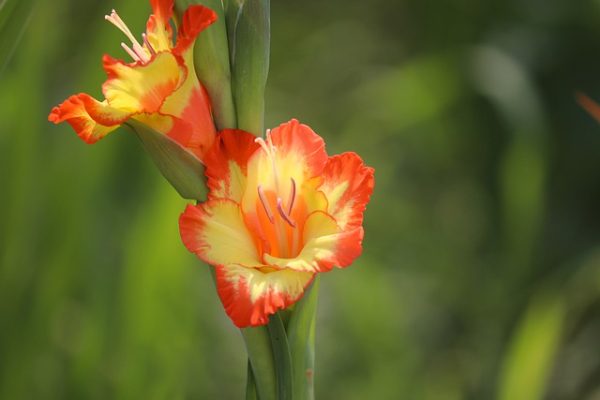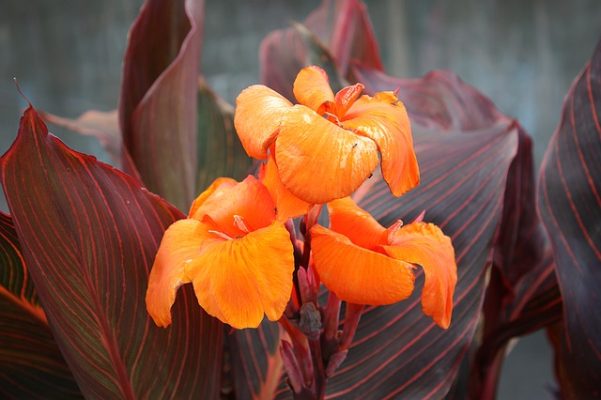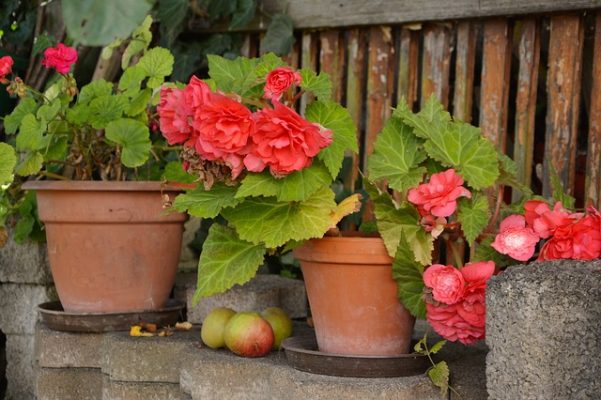Some flower bulbs are meant to be planted once the soil is warmer. Here’s a fantastic chart with those spring-planted bulbs that flower all summer long and often into the fall for amazing color! Think dahlias, lilies, gladiolus, iris, begonia, and more! We list the name, hardiness zone, sun/shade, blooming season, and more!
| Common Name | Hardiness Zone | Soil | Sun/Shade | Spacing (in) | Depth (in) | Blooming Season | Height (in) |
|---|---|---|---|---|---|---|---|
| Allium | 3–10 | Well–drained/ moist |
Full sun | 12 | 3–4 | Spring to summer | 6–60 |
| Begonia, tuberous | 10–11 | Well–drained/ moist |
Partial shade/Full shade | 12–15 | 1–2 | Summer to fall | 8–18 |
| Blazing star/gayfeather | 7–10 | Well–drained | Full sun | 6 | 4 | Summer to fall | 8–20 |
| Caladium | 10–11 | Well–drained/ moist |
Partial shade/full shade | 8–12 | 2 | Summer | 8–24 |
| Calla lily | 8–10 | Well–drained/ moist |
Full sun/partial shade | 8–24 | 1–4 | Summer | 24–36 |
| Canna | 8–11 | Well–drained/ moist |
Full sun | 12–24 | Level | Summer | 18–60 |
| Cyclamen | 7–9 | Well–drained/ moist |
Partial shade | 4 | 1–2 | Spring to fall | 3–12 |
| Dahlia | 9–11 | Well–drained/ fertile |
Full sun | 12–36 | 4–6 | Late summer | 12–60 |
| Daylily | 3–10 | Adaptable to most soils | Full sun/ partial shade |
12–24 | 2 | Summer | 12–36 |
| Freesia | 9–11 | Well–drained/ moist/sandy |
Full sun/ partial shade |
2–4 | 2 | Summer | 12–24 |
| Garden gloxinia | 4–8 | Well–drained/ moist |
Full sun | 12 | 3–4 | Summer | 6–20 |
| Gladiolus | 4–11 | Well–drained/ fertile |
Full sun/ partial shade |
4–9 | 3–6 | Early summer to early fall |
12–80 |
| Iris | 3–10 | Well–drained/ sandy |
Full sun | 3–6 | 4 | Spring to late summer | 3–72 |
| Lily, Asiatic/ Oriental |
3–8 | Well–drained | Full sun/partial shade | 8–12 | 4–6 | Early summer | 36 |
| Peacock flower | 8–10 | Well–drained | Full sun | 5–6 | 4 | Summer | 18–24 |
| Shamrock/sorrel | 5–9 | Well–drained | Full sun/ partial shade |
4–6 | 2 | Summer | 2–12 |
| Windflower | 3–9 | Well–drained/ moist |
Full sun/ partial shade |
3–6 | 2 | Early summer | 3–18 |
5 Tips for Planting Summer Bulbs
Just remember: Plant AFTER any chance of frosts in your area; these bulbs are not frost-tolerant. See the Almanac Frost Calculator for your zip code.
When buying bulbs, look for tubers with three to five eyes and initial root formation. In general, look for firm and healthy bulbs. Bulbs that are mushy usually have not been kept in a cool, dry place and will rot and therefore not flower.
Summer-flowering bulbs and tubers can be planted in the spring when you are certain that the ground will no longer freeze in your area. This may be up until the end of May, depending on your area. The bulbs need sufficient water and humid conditions.
The rule of thumb is to plant the bulb or tuber about 5 inches deep—except for dahlias and begonias, which should be planted just beneath the surface.
Once your summer bulbs have finished blooming, they can often be used again the following year. With the exception of lilies, the bulbs have to be taken out of the ground if it freezes in your area during the winter. If it does freeze in your area, let the leaves die down naturally, and then dig up the bulbs and store in a cool dry place to replant the following spring.
Popular Summer and Tropical Bulbs
Below we’ve highlighted some popular, colorful summer bulbs for the garden to keep the blooms going all season long!
Gladiolus
Gladiolus corms can be planted as early as soon as danger of frost has passed. Plant the corms 4 inches deep and 6 inches apart and stagger planting dates to have flowers all summer long. See our complete Guide to Growing Gladiolus.

Dahlias
Gorgeous tall dahias do not tolerate frost, so plant the tuberous roots after all frost possibilities have passed. Dahlias usually require support; drive a stake into the ground 12 inches deep and 6 inches behind the root at the time of planting. See our complete Guide to Growing Dahlias.

Cannas
Cannas can be planted directly in the garden in mid-May. Plant canna rhizomes 6 inches deep and 18 inches apart in late spring and after the danger of frost has passed.

Tuberous Begonias
Tuberous begonias can’t be planted in the garden until mid-May. Plant the tuberous begonia roots (which may be up to 1 ½ inches in diameter) 4 inches deep in a partially-shaded area.

Winter Storage
Note that most of these summer-flowering bulbs are “tender” and can not bear frost come fall. So, if you live in colder climates, they need to be dug up and stored until spring. If this is too much trouble, treat them as annuals and do not expect them to come back (if they do, bonus!).
How to store? Once the frost has killed the foliage (but before the ground is frozen), just remove the foliage and dig them up. Shake off excess soil and let dry for a couple days. Then store in sawdust or dry peat moss in boxes, not plastic bags. Place in a storage area that is dry and about 45 degrees F. Do not allow to freeze. If plants are in pots, merely cut the frosted foliage off and place pots in a non-freezing but cool location. You shouldn’t need to water until next spring.
Article courtesy of the Farmer’s Almanac
